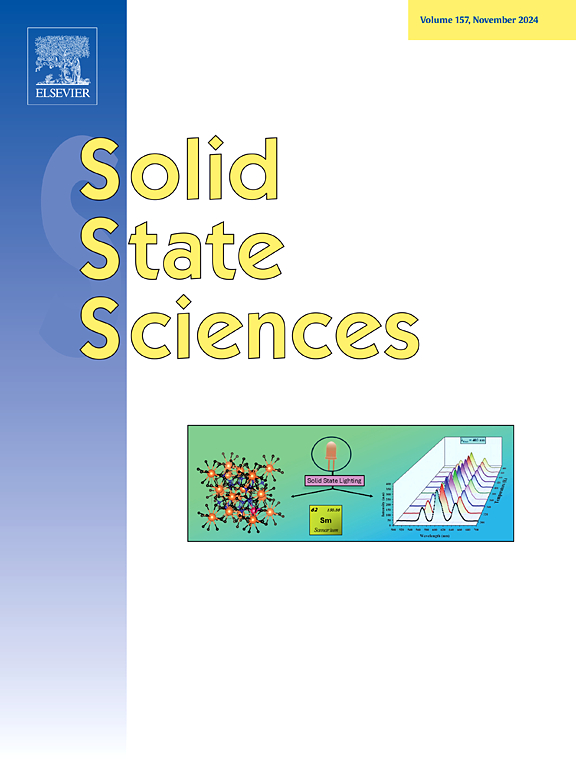用于固态照明器件的硼酸盐玻璃中Gd3+向Sm3+和Eu3+的能量传递机理研究
IF 3.4
3区 化学
Q2 CHEMISTRY, INORGANIC & NUCLEAR
引用次数: 0
摘要
本研究为硼酸盐玻璃中Gd3+到Eu3+和Sm3+离子的光谱特性和能量传递机制提供了有意义的信息。本研究的主要目的是提高所开发的玻璃的发光性能,使其适合固态照明(SSL)应用。该研究证明了有效的能量传递机制,有助于优越的发射特性。采用高温熔融退火技术合成了不同掺杂量Sm3+、Eu3+和Gd3+的硼酸盐玻璃。利用透射率、光致发光(PL)和x射线激发发光(XEL)等光谱技术研究了合成玻璃的电子跃迁和发光特性。根据光吸光度谱计算光带隙和J-O强度参数。通过光致发光发射光谱确定了其辐射特性。色度坐标证实了橙红光发射,表明主体玻璃中存在从Gd3+到Sm3+和Eu3+的能量转移现象。结果证实,能量转移显着增强了发光特性,特别是在可见光区域,使玻璃成为固态照明应用的有希望的候选者,包括显示技术,荧光粉,照明设备和光电子。我们将在今后的研究中进行进一步的研究,以充分挖掘和最大限度地发挥这些玻璃材料的应用潜力。本文章由计算机程序翻译,如有差异,请以英文原文为准。
Investigation of energy transfer mechanism in Gd3+ to Sm3+ and Eu3+ in borate glasses for the application of solid-state lighting devices
This investigation provides insightful information on the spectral characteristics and energy transfer mechanisms from Gd3+ to Eu3+ and Sm3+ ions in borate glasses. The main purpose of this study was to enhance the luminescent properties of the developed glasses, making them suitable candidates for solid-state lighting (SSL) applications. The study demonstrated efficient energy transfer mechanisms, contributing to superior emission characteristics. Borate glasses tri-doped with varying amounts of Sm3+, Eu3+, and Gd3+ were synthesized using the high-temperature melt-annealing technique. Spectroscopic techniques such as transmittance, photoluminescence (PL), and X-ray excited luminescence (XEL) were employed to investigate the electronic transitions and luminescence properties of the synthesized glasses. The optical bandgap and J-O intensity parameters were computed from the optical absorbance spectrum. Radiative characteristics were identified from the photoluminescence emission spectra. The chromaticity coordinates confirmed orange-red light emission, indicating the energy transfer phenomena from Gd3+ to Sm3+ and Eu3+ in the host glasses. The results confirmed that the energy transfer significantly enhanced the luminescence properties, particularly in the visible region, making the glass a promising candidate for solid-state lighting applications, including display technologies, phosphors, lighting equipment, and optoelectronics. Further investigations will be conducted in future studies to fully explore and maximize the application potential of these glass materials.
求助全文
通过发布文献求助,成功后即可免费获取论文全文。
去求助
来源期刊

Solid State Sciences
化学-无机化学与核化学
CiteScore
6.60
自引率
2.90%
发文量
214
审稿时长
27 days
期刊介绍:
Solid State Sciences is the journal for researchers from the broad solid state chemistry and physics community. It publishes key articles on all aspects of solid state synthesis, structure-property relationships, theory and functionalities, in relation with experiments.
Key topics for stand-alone papers and special issues:
-Novel ways of synthesis, inorganic functional materials, including porous and glassy materials, hybrid organic-inorganic compounds and nanomaterials
-Physical properties, emphasizing but not limited to the electrical, magnetical and optical features
-Materials related to information technology and energy and environmental sciences.
The journal publishes feature articles from experts in the field upon invitation.
Solid State Sciences - your gateway to energy-related materials.
 求助内容:
求助内容: 应助结果提醒方式:
应助结果提醒方式:


